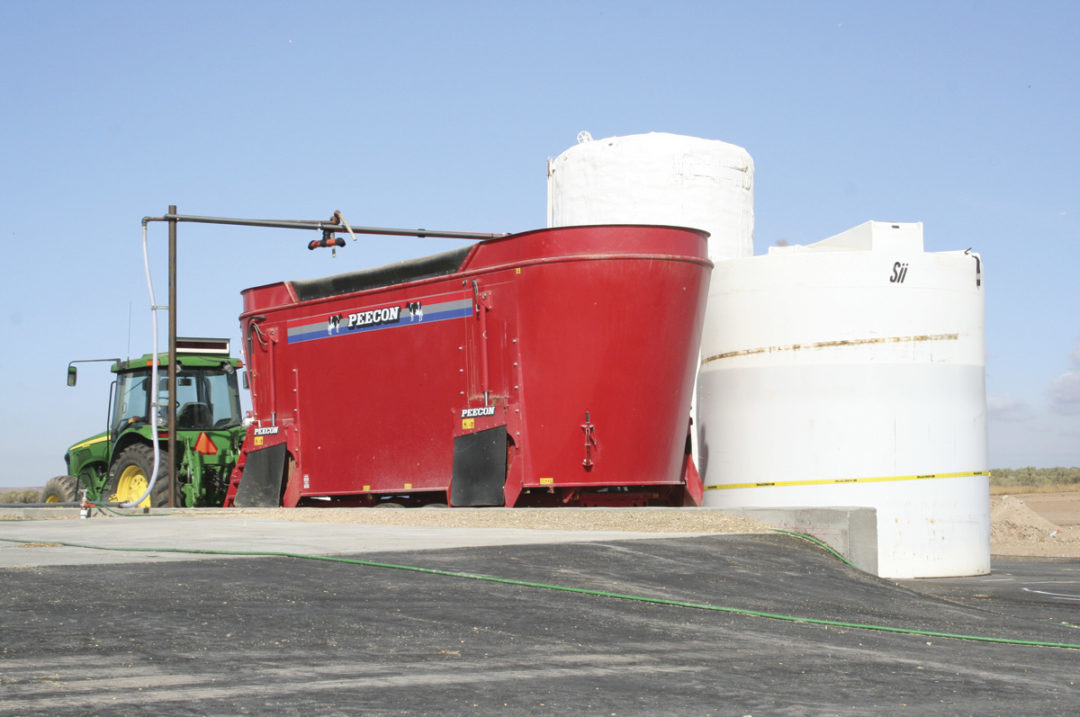Total mixed ration (TMR) mixers – and the people who operate them – are critically important to the success of dairy farms. A typical dairy operation manages different animal types (from young heifers to lactating cows), intakes and rations characteristics, resulting in a wide range of feed load sizes. Improper load size may cause issues with the uniformity of the TMR, which may lead to nutrient intake imbalances and suboptimal health and performance for cows within the same pen. There are numerous options when it comes to the type, size and features of TMR mixers. Following are a few variables to consider when selecting a TMR mixer that is the right size for your operation to achieve optimal process efficiency and TMR uniformity.
1. Mixer volume and ration density
TMR mixer capacity is commonly expressed in volume and maximum load weight. Manufacturers estimate maximum load weight by using an assumed ration density expressed in pounds per cubic foot. A review of TMR mixer literature revealed that ration density assumptions ranged from 25 to 32 pounds per cubic foot. Thus, two mixers with the same volume capacity may specify two different maximum load weights depending on the ration density assumption. While weight is a more familiar metric for many, volume and density should be the primary determinants of mixer size needs.
It is critical that the density of typical rations fed is estimated as part of the process of sizing a TMR mixer. Actual ration density is highly influenced by the forages and concentrates used on-farm; a dry-cow ration with grass hay or straw will be less dense than a milk-cow ration with corn silage, haylage, a greater proportion of concentrates and liquid ingredients such as whey or molasses. A quick way to determine ration density is to fill a standard 5-gallon bucket level full with fresh TMR, weigh the contents (accounting for the weight of the bucket), and multiply by 1.5 to determine pounds per cubic foot.
Next, we can use ration density and feed intake values to convert feed weight to volume. Table 1 shows an example of this calculation.

In this example, all rations are 50% dry matter, and feed intake (as-fed basis) for dry cows, first-lactation milking cows and mature milking cows are 60, 100 and 140 pounds per cow per day, respectively. The dry-cow ration is bulky and has a ration density of 15 pounds per cubic foot, whereas the milk-cow rations have a density of 25 pounds per cubic foot. Dividing as-fed feed intake by ration density gives us feed volume per cow per day; mature milking cows consume 5.6 cubic feet of TMR, while the dry-cow ration will occupy 4 cubic feet.
Now we will want to consider the largest and smallest loads expected to be mixed. Using the example herd in Table 1, the largest load is the mature cow pen (110 cows) and the smallest load is the dry cow group (80 cows), which, when multiplied by feed volume per cow, gives us load sizes of 616 cubic feet and 320 cubic feet, respectively.
2. Effective mixer capacity
Continuing with this same example, we now know that the new mixer needs to be larger than 616 cubic feet, but also should be able to adequately mix the dry-cow ration. Mixer capacities are typically listed as volume at “struck” level (or level full). However, how volume is calculated may vary by mixer type and manufacturer. Addition of a rubber ring on the top of the mixer will typically increase total volume. It is recommended that mixers should be filled to 75% to 95% of struck capacity to allow for adequate mixing and to minimize feed shrink.
Horizontal reel-auger mixers are recommended to be filled to the lower end of the range. For adequate mixing, there should be 4 to 6 inches between the feed and the rails on the reel at the 12 o’clock position to allow for lifting and falling of the feed. Vertical mixers can be filled to the higher end of the range with a rule of thumb that feed should not exceed 2 feet above the top of the augers. For our example herd’s largest load, a horizontal reel-auger mixer should be sized at 821 cubic feet at 75% of struck volume, while a vertical mixer with a capacity of 684 cubic feet would represent 90% of struck volume. If more capacity is needed, consider increasing the number of loads to a pen rather than overloading the mixer.
Underfilling is a concern, particularly for vertical mixers and for smaller loads, like those for dry-cow or post-fresh groups. Risks can be minimized by always loading vertical mixers in the center to allow for optimal distribution of ingredients. In addition, ingredients should be added near the wall of the mixer box, and final mix RPM should be adequate to reduce the chance of ingredients remaining on the augers and not being delivered to the cows.
3. Additional considerations
When sizing a TMR mixer, a producer may also want to account for feedstuff changes that affect ration density, as well as seasonal fluctuation or future expansion impacting cow numbers. We recommend evaluating the performance of the mixer by observing the mixing process and assessing ration uniformity using a Penn State Particle Separator.
While mixer size is a critical component to get right, additional best practices can effectively widen the margin of safety for achieving a quality TMR. Ingredient loading sequence, mix time after the last ingredient, mixer levelness, forage particle size, distribution of liquid feeds, consistent determination of forage dry matter, and routine maintenance and service are important as well.
Finally, when choosing a mixer for your operation, consider the height of the mixer relative to your facilities and equipment, as well as the horsepower required to operate the mixer. Look for a manufacturer and dealer that can provide prompt and adequate product support and access to replacement parts.
The TMR mixer and its operator are critical to ensuring timely delivery of a uniform TMR to lactating cows and other groups on a dairy. Knowing the capabilities and limitations of a TMR mixer, as well as the density of the rations fed, is important for determining what size and type of TMR mixer is right for an operation.






